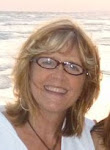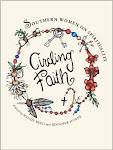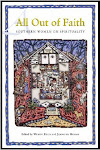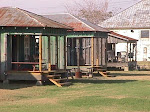
Studying my notes from this weekend’s
Yoknapatawpha Summer Writers Workshop in Oxford, Mississippi, is like taking a course in the art and craft of writing. In addition to the manuscript critique sessions, led again this year by Scott Morris, there were three “craft talks” and an informational session with publicist (and former literary agent),
Stella Connell. And while I’m anxious to get to work making revisions to my novel-in-progress, “Cherry Bomb: A Tryptich,” I’m just as eager to share a few treasures from this weekend, so here goes.
Scott Morris has been living in LA for the past year or so, so he is, I think, qualified to speak to the immediacy that film and painting have, that isn’t perhaps as available to the writer. But he also spoke about the interior world that is best explored by the writer. Actually, he said that writing is
“the only art that can convey consciousness.” [As an iconographer, I’m not sure I completely agree, since icons draw the heart and soul into a spiritual realm in a way that secular art does not. Henri Nouwen wrote that icons
“are created for the sole purpose of offering access, through the gate of the visible, to the mystery of the invisible.” But I’m pretty sure Scott wasn’t thinking of icons when he spoke of art.]

A scientist will explain color as refraction of light, but a child will ask,
“but where is the color red?” “Human beings see color. They participate in the mental life,” Scott said.
“When they fall in love, the scientists say it’s a reductionist survival thing… but there is the thought—the idea of love.” He spoke of Faulkner’s advice that
“the best writing is about the human heart in conflict with itself.”
He encouraged us to expand our palettes as writers, to
“give a damn about people in the most incredibly sensitive sort of way” in order to show what the world looks like to that person, to that character. He called this
“empathetic imagination.” His words here built on a foundation he laid with his talk back in 2008,
“Learning to See and Write Sunsets.”
Every year at this workshop, we gather a few more tools for our writers toolboxes (more about that later in this post) and we study the “how-tos” of our craft. But every year, Scott seems to make us dig deeper, into the world we know and the world we are trying to paint with our words. Last year he spoke about
“The Writer’s Cross: Transcending the Existential Shorthand.” 
Every year we’re on the edge of our seats, trying to expand our understanding of the task at hand. He quotes Tolstoy, who says we must have a fresh view of the universe. And Mississippi writer, Lewis Nordon, who says you have to
locate the moral heart of your book and nail it. It’s about intimacy—about revealing the deepest sense of who someone is—and the good news is that the writer can often do this when no one else can, through skillful dialogue, story structure, and building momentum. The writer can “go where angels fear to tread.”
 Sean Innis
Sean Innis built on Scott’s words with his craft talk on Saturday,
“Actually Writing: Inspiration, Creation, Revision.” This was my second time to sit at Sean’s feet—the first time was back in August of 2007, at the first
Mississippi Writer’s Guild Conference. He’s a great teacher, and I hope I came away with a few more tools in my box. I think my best new tool is Sean’s wisdom about one of the most difficult parts of a book to write—
the ending. Drawing from Aristotle’ “Poetics,” (Sean was a philosophy major) he said that every good drama must be both surprising and inevitable. You want to surprise the reader (I didn’t see that coming!) but not jar him out of the flow of the story. And when you’re not sure when to end the story,
“give your characters one more day.” This keeps the plot moving. And when you finally say enough, don’t wrap everything up too neatly.
“Good conflict resonates.” Even in the revision process,
“good editing opens up rather than closes down the story.”

And then on Sunday morning
Neil White’s talk on
“The Art vs. the Craft of Creative Writing” gave us even more tools, tips and inspiration. (Neil has a terrific memoir out in both hardback and paperback now,
"In the Sanctuary of Outcasts.")There was no need for Neil to apologize to Doug and me (which he did) because we had both heard him give this talk at the
Seaside Writers Workshop last fall, because I could hear this over and over and always find something fresh to work with. I think Neil’s “cinematic scene machine” diagram is what’s staying with

me the most vividly. He showed us how to create scenes using our brain, five senses, dialogue, description and action, but also how to separate out the “art” side of writing from the “craft” side. All that and more in 45 minutes! At one point during his talk, a workshop participant raised his hand and said,
“Now this is what I came to this workshop for!” We all

laughed. There had already been two full days of craft talks, critique sessions, and open mics, but the “how tos” that Neil presented were the tools this man had been waiting for all weekend. I think many of us felt this way during each event!
When I think back about the weekend, I realize that one thing that makes the Yoknapatawpha Writers Workshop special is the balance the faculty always brings—feeding both sides of our brains, arousing our psyches, filling our toolboxes, and inspiring us to do the hard work of sitting down and putting words on the

page every day. I can never hear too much about
voice—the personality that emerges through the telling of the story—and about the importance of every sentence, every word, which communicate the story. And for me, personally, having switched genres from memoir to novel since last year’s workshop, it was encouraging to hear Scott say that I’ve “gotten above the volatile material.” I’m not sure I could have ever done that with memoir (or certainly not as well as Mary Karr, Augusten Burroughs, Anne Lamott, Haven Kimmel and others have done it) so I’m excited to be moving forward with a piece of fiction.

Another highlight of the weekend was Neal Walsh’s reading (and signing) of his new book,
The Prospect of Magic, at
Off Square Books on Saturday night. After four years of learning from Neal at these workshops, it was such a joy to see his magic in print and to share in the celebration of his book.
Oxford author, Tom Franklin, introduced Neal, and the crowd hung on his every word during the reading. Kudos, Neal!

My fellow workshop participants are always a huge part of the weekend for me, and friendships are always formed (and sometimes writing critique groups) that last for years. I was especially happy to spend time with two other “emerging writers” I’ve met in the past few years, Keetha Mosely, from Winona, Mississippi, and Ellen Ann Fentress, from Jackson, Mississippi. Keetha and I met at the first Mississippi Writers Guild Conference in 2008, and Ellen Ann and I were both presenters at the
Southern Women Writers Conference at Berry College last fall. Renewing these friendships in invaluable to me.

Coincidences often happen, but I didn’t see this one coming: Rick Ward and I ended up sitting next to each other during the workshop, and I discovered that he replaced my father on the Mississippi Charitable Gaming Commission when my dad died back in 1998. Rick’s book,
The Lawmaker, is a fictionalized story of the corruption and coverup that took place (and still does) in the Mississippi casinos. I’ll save the juicy details for a later post when I review the book.

So now it’s back to work on the novel. Can’t wait to dive in and apply what I learned about the art and craft of writing this weekend, not only from Scott, Neil and Sean, but from my fellow participants. (a record 20 folks this year!) Their feedback is in valuable to me, as others striving with me to explore the interior world through writing, to learn to see colors and to show them to our readers.
Here’s to you: John, Ellen Ann, Karen, Steve, Thomas, Gretchen, Oxana, Eli, Keetha, Donna, Meg, Rick, Doug, Ben, Clyde, Lesleigh, Patti, Corrine and Bobbie!
.jpg) All that said, as I plan to leave for a week on the Gulf Coast tomorrow (watch for fun posts from Gulf Shores) I don't want to leave you guys without a fun blog post, so I'm going to point you in the direction of A Good Blog is Hard to Find, and its most recent post, "Hooked on the Oxycondoms," by Lauretta Hannon. I enjoyed meeting Lauretta at the Girlfriend Weekend in Jefferson, Texas, in January. She'll also be a speaker at the Mississippi Writer's Guild's 4th annual conference in Vicksburg, Mississippi, August 6-7.
All that said, as I plan to leave for a week on the Gulf Coast tomorrow (watch for fun posts from Gulf Shores) I don't want to leave you guys without a fun blog post, so I'm going to point you in the direction of A Good Blog is Hard to Find, and its most recent post, "Hooked on the Oxycondoms," by Lauretta Hannon. I enjoyed meeting Lauretta at the Girlfriend Weekend in Jefferson, Texas, in January. She'll also be a speaker at the Mississippi Writer's Guild's 4th annual conference in Vicksburg, Mississippi, August 6-7.












































































